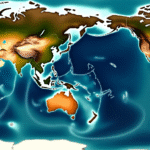Introduction
In 2024, the world witnessed a grim year for tropical forests and biodiversity, with alarming data released by the World Resources Institute, based on research from the University of Maryland. The crisis is most severe in developing tropical nations, grappling with poverty and institutional weakness.
The Extent of Deforestation
An astounding 94% of global deforestation occurs in tropical countries, with 2024 marking a horrifying milestone: the destruction of 6.7 million hectares of primary tropical rainforest. This area is equivalent to Panama or the Mexican state of Veracruz.
Causes of Deforestation
The primary cause remains catastrophic fires, primarily ignited by farmers and ranchers to clear land for agriculture and livestock grazing. These fires spread uncontrollably, devouring tens, hundreds, or thousands of hectares of tropical forests with each deforestation event. Consequently, countless plant and animal species—including mammals, birds, reptiles, amphibians, and insects—disappear.
The Fragility of Tropical Forests
Tropical forests are the planet’s largest biodiversity reservoir, characterized by delicate ecosystems and often nutrient-poor soils. Nutrients circulate perpetually within complex ecological chains rather than accumulating in the soil. On slopes, deforested lands erode rapidly, rendering them largely unproductive. Although some abandoned lands may undergo ecological succession and recovery over decades, farmers and ranchers frequently prevent this by repeatedly setting fires.
Exacerbating Factors
Global warming intensifies the situation. Longer, drier, and hotter summers and droughts make understory vegetation a potent fuel source. Farmers, ranchers, and settlers ignite these flammable materials, triggering massive firestorms that consume thousands of hectares. Burned lands invite colonization and agricultural exploitation, perpetuating land-use change and deforestation.
Environmental Impact
Agricultural and livestock activities, both subsistence and commercial (mainly soybean farming) and cattle ranching, remain the most environmentally devastating economic activities. In 2024, global tropical forest deforestation was five times greater than in 2023, linked to the El Niño phenomenon that exacerbates droughts.
Country-Specific Impacts
The countries with the highest tropical deforestation in 2024 were Brazil, Bolivia, Democratic Republic of Congo, Indonesia, Peru, Laos, Colombia, Cameroon, Nicaragua, and Mexico.
- Indonesia: Despite past successes in containing and reducing deforestation since 2016, along with Malaysia, Indonesia continues to face challenges.
- Brazil: After improvements in previous years, particularly following Bolsonaro’s administration, Brazil worsened in 2024. Deforestation isn’t limited to the Amazon but also affects wetlands and seasonally flooded forests in Pantanal (Mato Grosso) and dry forests in Cerrado (central and northeastern regions).
- Mexico: Primary forest destruction nearly doubled between 2023 and 2024, with over 8,000 fires and the largest devastated area on record (according to CONAFOR). Agriculture and ranching, primarily in Campeche and Quintana Roo, driven by Mennonite communities clearing forests for soybean and sorghum cultivation without government intervention, are the main culprits.
- Russia and Canada: Although these non-tropical nations experienced significant fires in 2024, the affected areas typically recover due to lack of agricultural exploitation. Russia’s primary concern is the release of massive CO2 amounts from peatland (turber) fires.
Solutions for Tropical Deforestation
To tackle this pressing global issue, it’s crucial to establish zero-deforestation targets in the most affected countries and regions. Enforcing legality, upholding the rule of law, regularizing land ownership, compensating landowners for preventing deforestation (Payment for Ecosystem Services), restoring tropical forests on agricultural and grazing lands with carbon market assistance, creating and funding large protected natural areas, and building new international cooperation and financing systems are essential steps.






